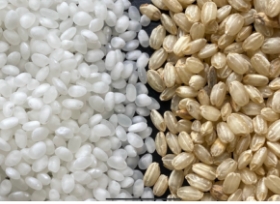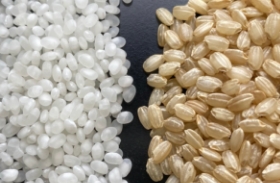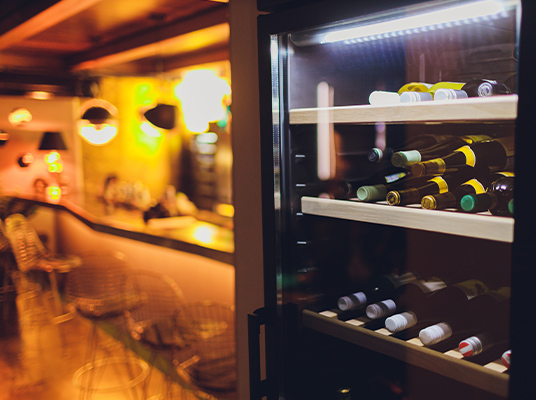There are two main types of sake. Junmai sake is made with rice and water alone, while honjozo/futsuu sakes are made by adding brewing alcohol to the rice and water. Nakamoto Sake Brewery exclusively makes junmai sake. Because the ingredients are simple, the aroma and flavor can vary greatly depending on the brewing method and the quality of the rice and water. Rice used in sake is polished before brewing. The portion of the grain that remains after polishing is represented as a percentage and called the Rice Polishing Ratio (RPR), and the category of junmai sake can be further subdivided based on the RPR.
Japanese sake is a very delicate beverage, and to ensure a fine taste, brewers must work carefully at each step from the polishing of the rice to the shipping of the final product.
①Polishing, Washing, Soaking, Steaming, and Cooling the Rice
Sake is made from rice specially suited for making sake, which is different from the rice normally used for food. The outer surface of the rice is rich in proteins and other substances that can produce the unwanted off-flavors known as zatsumi. The rice is therefore polished to remove these substances.
After being washed, the polished rice is soaked so that it absorbs the right amount of water for the next step in the process, steaming. Having absorbed water, the rice is loaded into a machine called a koshiki to be steamed from below. The steamed rice is removed from the koshiki while still hot and is cooled in a cooling machine with a conveyor belt.
②Making Koji
The rice is moved to a koji room where the temperature is regulated, and koji cultures are sprinkled on the rice to propagate. The substance made from the growth of the koji cultures is called "koji," and it has the function of converting the rice starch into glucose.
③Making the Shubo
Shubo literally means "sake mother" and refers to the yeast starter used when brewing sake. Yeast has the function of converting glucose into alcohol, and the brewing of sake requires large quantities of it. It is therefore cultivated by adding yeast to the mixture of water, koji, and steamed rice, and then letting it grow.
④Brewing
According to standard sake brewing processes, koji, steamed rice, and water are added to the shubo in three separate stages instead of all at once. Adding all of the ingredients at once and allowing them to ferment dilutes the acidity of the shubo, which increases the risk of microbial growth. In order to avoid the risk of the sake spoiling, brewers introduce the ingredients in three separate batches. This process is called sandan jikomi, which literally means, "three-stage preparation." The substance created by this careful and thorough three-stage process is called moromi.
⑤Pressing, Ori Removal, and Filtration
The moromi is pressed to separate it into sake and the sake lees. This is one of the operations where sake breweries can give their products a distinctive taste, as the amount of pressure used changes the flavor of the sake. Freshly pressed sake is cloudy with fine residues called ori suspended in it. The sake is left to stand in a tank for about 10 days to allow the suspended ori particles to settle to the bottom. This process is called oribiki, or ori removal. Following the oribiki, the clear, upper part of the liquid is removed from the tank.
Even after the oribiki, fine particles remain mixed in with the liquid, so it is filtered once more. Activated carbon is often used to remove colors and zatsumi off-flavors.
⑥Bottling, Pasteurization, and Storage
The filtered sake is bottled. Active enzymes remain within the sake, so it is pasteurized by heating it to between 60 and 65 degrees Celsius (140-149℉) to deactivate the enzymes and sterilize the product. We call the process "bottle heating," as we dip the sake-filled bottles in hot water. Once they have reached the prescribed temperature, we rapidly cool them, putting the heated bottles of sake in a refrigerator for storage and aging. Depending on the sake, brewing water may be added either before the pasteurization or between pasteurization and shipping to adjust the alcohol content or flavor.



